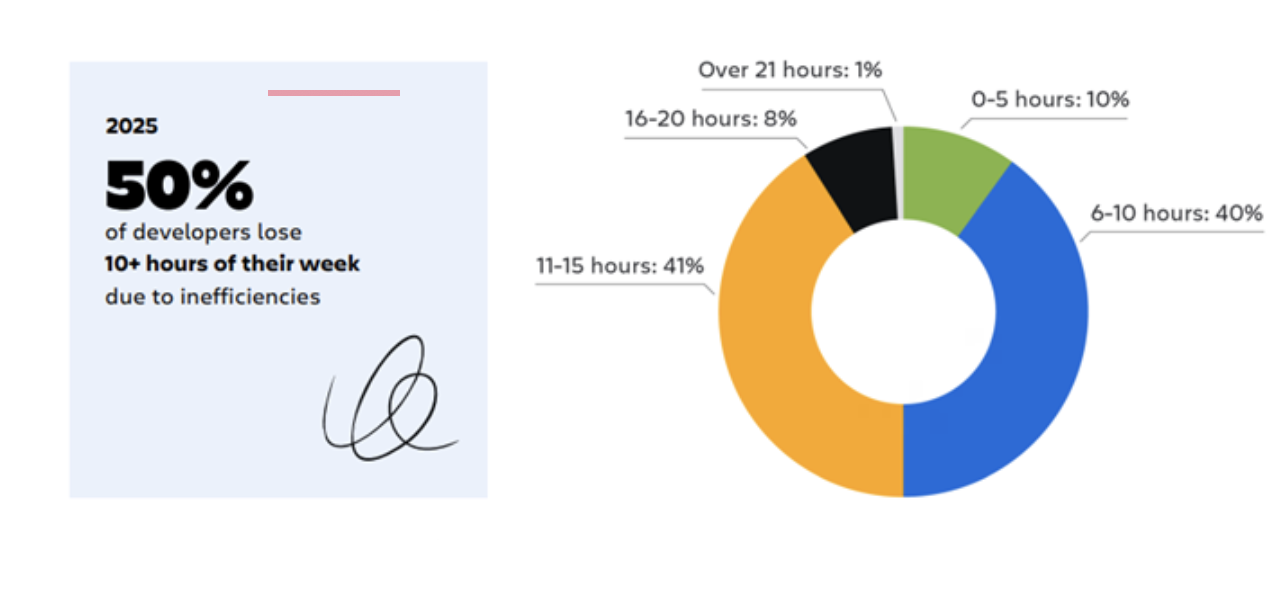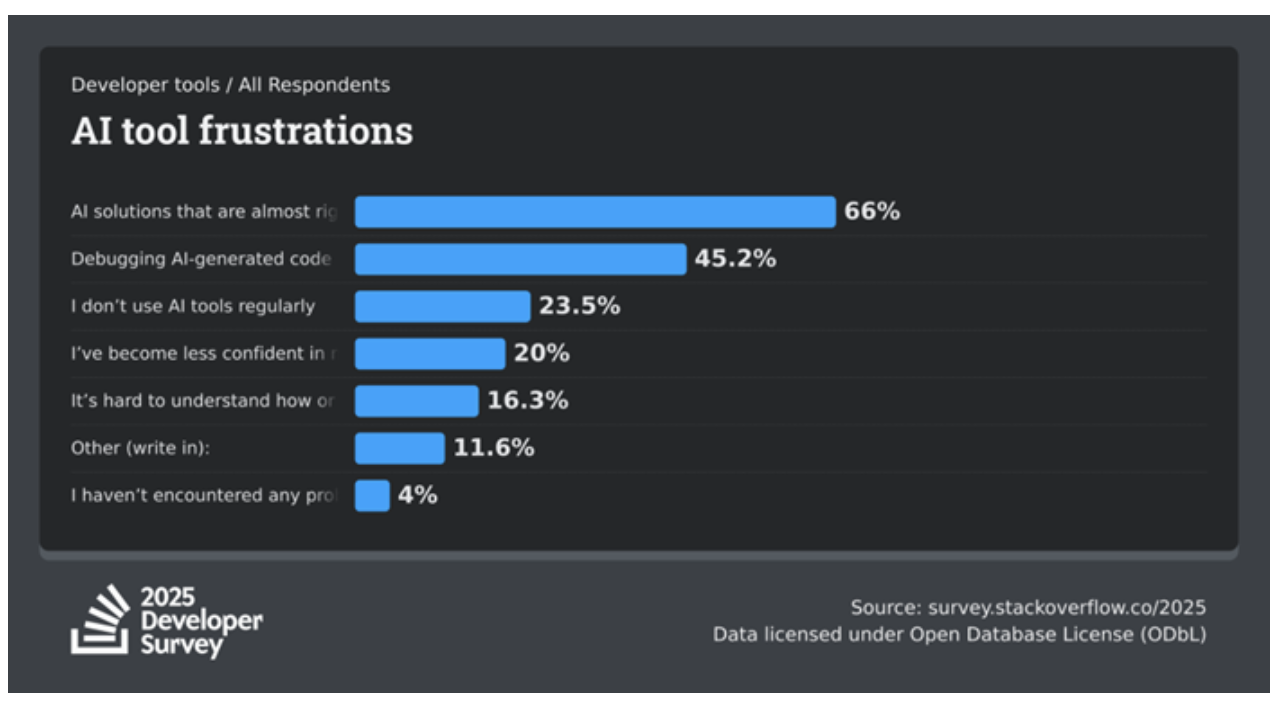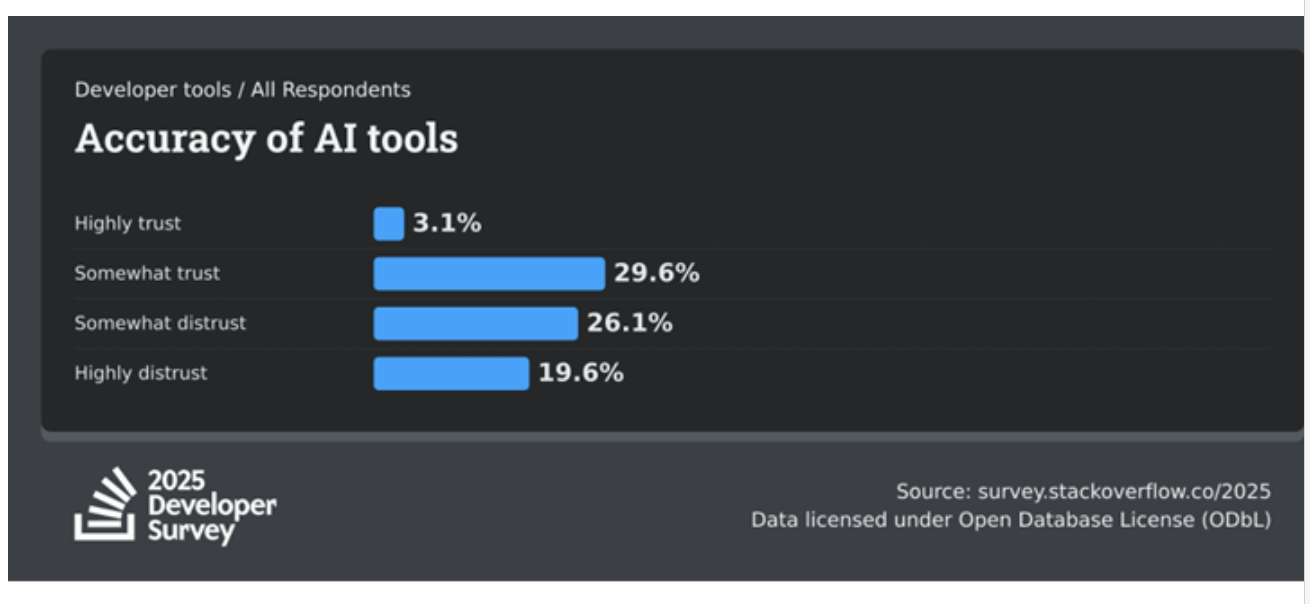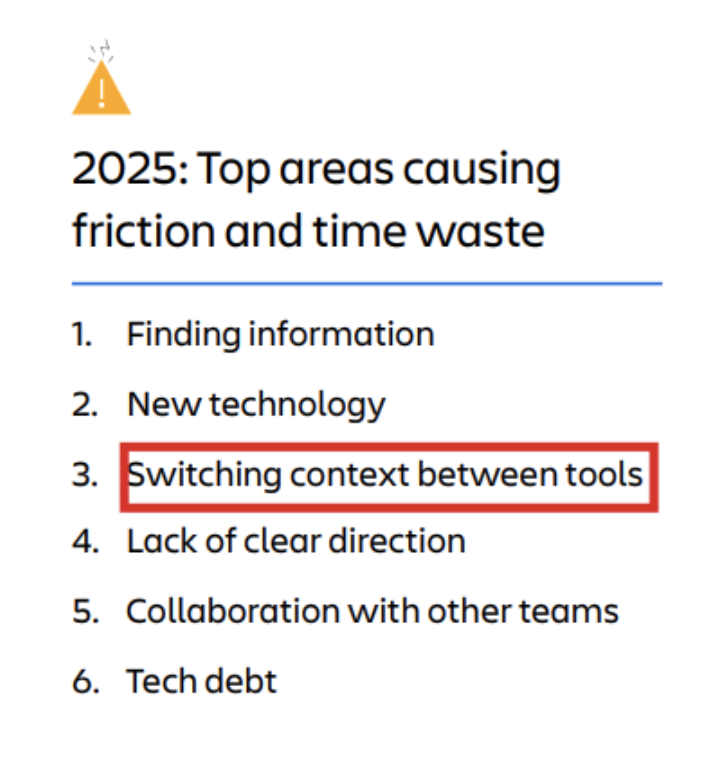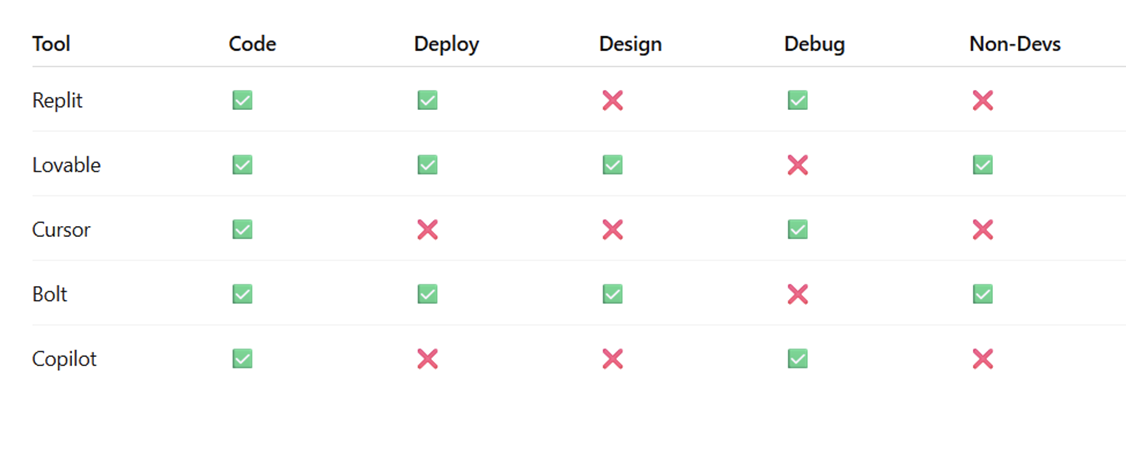
The Boom: AI Dev Tools Are Everywhere, But Don’t Work Together
AI dev tools have exploded in the last two years, backed with billions in funding, big promises, and new features like autocompletion, scaffolding, debugging, and one-click deployment. Each promises to save time and boost productivity, but they don’t work together.
We have lots of smart, specialized helpers, but no single, full-stack AI tool that can handle the entire dev process. Developers and vibe coders are left stitching together workflows with GitHub Copilot, ChatGPT, CI/CD services, and no-code UI builders just to get an app out of the door.
The Problem: A Fragmented Mess of Disconnected Tools
Most AI dev tools feel like scattered parts of a broken machine. One auto-completes code, another sets up cloud infrastructure, and a third helps with debugging. Each tool offers a slight productivity boost, but because they don’t talk to each other, developers end up stuck in glue work.
Atlassian’s 2025 DevEx report found that 68% of devs save 10+ hours per week with AI, but 90% still lose time to inefficient workflows.
Ten hours a week of inefficiency is a loss of $7,917,000 annually for a company with 500 developers.
Source: State of Developer Experience Report 2025 | Atlassian
Source: Stack Overflow Survey
Devs still lose hours switching tools, setting up environments, reviewing code, or sitting through meetings. You have to constantly babysit each tool, and none of them reduce mental load. The missing piece would be tools that help Devs stay in flow.
According to the 2025 Stack Overflow Survey, 84% of developers now use or plan to use AI tools, yet 46% say they don’t fully trust AI-generated outputs.
Source: Stack Overflow Survey
You write code in one tool, then manually copy it to another. You get a bug fix from an AI assistant, then paste it back into your editor. Nothing is shared, no memory of the project, no context is carried over. Some have proposed a universal protocol to fix this, but we’re not there yet.
Source: State of Developer Experience Report 2025 | Atlassian
Devs lose flow, repeat themselves constantly, and juggle tools instead of building software.
The Consequences: Lost Flow, Slower Teams, Higher Costs
An integrated AI dev platform could change everything.
For non-coders, it would open the door to building apps without needing to hire engineers. Tools like Replit and Lovable already hint at this: describe your idea in plain English, and they generate the front-end, backend, and deployment for you.
For developers, it means less context switching, fewer tabs, and faster shipping. Instead of bouncing between GitHub, AWS, and Slack, everything could happen in one place. GitHub reported a 55% boost in coding productivity from AI autocompletion alone; imagine that multiplied across the entire dev cycle.
One person could be hired, thereby replacing the entire engineering team. That means more software, built faster at a lower cost.
The Contenders: Who’s Chasing the All-in-One Dream
A wave of startups and tech giants are racing to build the first all-in-one AI dev stack. Each approaches it from a different angle.
Source: ChatGPT
-
Replit
Replit started as a simple browser IDE, but it’s now a full dev environment. It lets you code with others, deploy with one click, and get help from its AI assistant, Ghostwriter, which can autocomplete, explain code, and write tests.
You can write, run, and ship apps in one place without juggling multiple tools, but it’s not perfect. Senior devs often hit limits with the browser setup, and Ghostwriter’s suggestions aren’t always ready for production. Developers typically prototype on Replit before moving to local setups or utilizing other tools for more control.
Replit has introduced a new feature that lets you build apps with a prompt. That includes front-end, back-end, database, and a cloud setup. Every app comes with built-in auth and storage. It lets you tweak features by chatting and deploys it to a live URL with one click.
It can build and ship an app from your phone, but the AI struggles with complex logic, and senior devs might miss the flexibility of their stack.
-
Lovable
Lovable is a no-code AI app builder that it claims is made for non-developers like founders or anyone with an idea. It lets you describe your app in plain English and builds it for you with a clean UI using React/Tailwind, a working backend with Node.js or Supabase, and a ready-to-go design.
Lovable claims it is 20x faster than coding. It lets you edit the app through a chat or visual editor like Figma and then deploy it with one click. It syncs to GitHub and supports collaboration, allowing devs to step in if needed. It’s great for simple apps and MVPs, especially for folks who don’t code, but backend logic and complex apps may need to be taken outside Lovable for full control.
It’s fast, friendly, and powerful for early-stage ideas, but not built for complex software.
-
Cursor
Cursor is built for people who already know how to code and want help writing, editing, and managing their projects faster.
You can chat with it to generate code, fix bugs, and refactor things across your whole project. There’s also an agent mode where you tell it what you want done, and it figures out the steps.
It’s great for big projects and feels like a natural part of the coding flow, but it stops at coding. You can’t deploy your app; you’ll need something like Replit for that. It’s not beginner-friendly, lacking a drag-and-drop builder and no-code features.
Cursor is great for coding, but you’ll need other tools to launch your app.
Like Lovable, it can generate full-stack apps from a prompt (using Node and React) and auto-run them to check if they work. You can deploy apps with one click via Netlify for quick demos.
It has limited editing features; you’ll likely have to export the code and continue elsewhere for serious changes.
-
GitHub Copilot
Github Copilot, originally an autocomplete tool, has evolved into Copilot X. It now aims to handle tasks, such as writing multi-file code, tests, and pull requests. It introduced ‘’Copilot Agents’’ that can run tests or debug on command, showing that big players are also trying to stretch AI across the full dev cycle.
But even with these upgrades, Copilot still focuses on coding. It doesn’t handle deployment, runtime, or CI/CD. You still need other tools to get your code live.
Each tool covers part of the workflow, but none covers it all. Replit excels at coding and deployment, but struggles with complex systems. Lovable handles design to deploy but only for simple apps. Cursor is excellent for deep coding tasks, but doesn’t do hosting or design. Copilot works well inside the editor but stops at your repo’s edge.
It’s just a growing patchwork that devs have to stitch together. There’s no ‘’single pane of glass’’ for building software using AI.
The Vision: What a True All-in-One AI Dev Should Look Like
It starts with a prompt. You describe your idea in natural language, and the platform builds the full stack: front end, backend, auth, database, and a cloud setup. You can refine the UI visually like Figma, tweak logic via chat, and test with one command. Version control is built in. Deployment happens in the same interface.
Every layer, design, code, data, and infrastructure is aware of the others, with no handoffs, tab juggling, or explaining your intent to a different tool.
A workspace where building software feels as fluid as drafting a document, and right now, no one offers that.
The Blind Spot: Everyone Sees It, No One’s Solved It
Everyone sees the same problem. Developers are tired of context switching. Non-technical founders aim to build without hiring employees. Meanwhile, Investors are backing AI development tools with billion-dollar bets. Replit hit unicorn status, and Cursor reached a $9B valuation.
But until someone ties everything together, we’re stuck with a patchwork. The real winner will be the one that ties the whole pipeline together. That tool could be the Microsoft Office for software.
The opportunity is huge. The need is clear, and whoever cracks this blind spot will reshape how software is made, who makes it, and how fast it ships.
In a world like that, building software could be as simple as writing a sentence.

